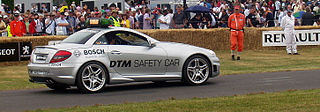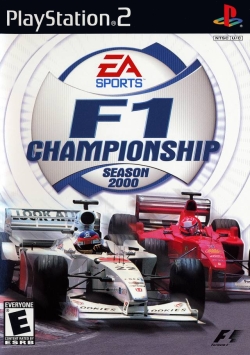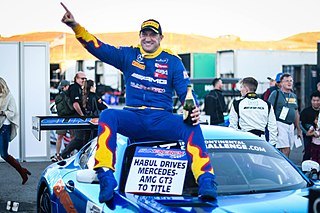
In motorsport, a safety car, or a pace car, is an automobile which limits the speed of competing cars or motorcycles on a racetrack in the case of a caution period such as an obstruction on the track or bad weather. The aim of the safety car is to enable the clearance of any obstruction under safer conditions, especially for marshals and/or await more favourable track conditions weather-wise. By following the safety car, the competitors' tyres remain as close as possible to operating temperature while their engines do not overheat. A safety car is also preferred over stopping the race and restarting as the latter takes longer.

18 Wheeler: American Pro Trucker, known in Japan as 18 Wheeler, is an arcade game developed by Sega AM2 and distributed by Sega. The game was released in arcades in 1999 and ported to the Dreamcast in 2000. It was released for the PlayStation 2 in 2001 and GameCube in 2002 by Acclaim Entertainment. Sega followed up on the success of 18 Wheeler with a sequel, The King of Route 66, which was released in the arcades in 2002 and ported to the PlayStation 2. This was one of the final arcade games to be ported to the Dreamcast after its discontinuation, before Sega became a third-party developer.

The Mercedes-Benz Atego is a range of general-purpose rigid trucks introduced by Daimler Truck in 1998. A new model was introduced in 2004, followed by a facelift in 2010 and another new model in 2013. The latest version is available in gross vehicle weights of 6.5 to 16 tonnes (t) and is powered by a straight 4- or 6-cylinder engine.

4x4 Evo is a video game developed by Terminal Reality for the Windows, Macintosh, Sega Dreamcast, and PlayStation 2 platforms. It is one of the first console games to have cross-platform online play where Dreamcast, Macintosh, and Windows versions of the game appear online at the same time. The game can use maps created by users to download onto a hard drive as well as a Dreamcast VMU. All versions of the game are similar in quality and gameplay although the online systems feature a mode to customize the players' own truck and use it online. The game is still online-capable on all systems except for PlayStation 2. This was Terminal Reality's only video game to be released for the Dreamcast.

F355 Challenge is a 1999 racing simulation arcade video game based on the race car and Ferrari event. It was developed by the AM2 division of Sega for the Sega Naomi Multiboard arcade system board under the direction of Yu Suzuki, and was later ported to the Dreamcast and PlayStation 2 home video game consoles under the names F355 Challenge: Passione Rossa and Ferrari F355 Challenge respectively for both American and European releases. The only model of car featured in the game is the Ferrari F355 Challenge model. Unlike Sega's other arcade racers like Out Run titles, F355 Challenge aimed to be realistic. The game was considered the most accurate simulation of the F355 possible up until that time.

NASCAR: Dirt to Daytona is a racing simulator developed by Monster Games and published by Infogrames in November 2002 for the PlayStation 2 and GameCube. It features NASCAR's Dodge Weekly Racing Series, Featherlite Modified Tour, Craftsman Truck Series, and the NASCAR Winston Cup Series. The Dodge Weekly Racing Series and Featherlite Modified Tour rosters consist of generic fantasy drivers. The Craftsman Truck Series also features fantasy drivers alongside real ones. The unique feature of having to work your way up through the ranks from the low tier Weekly Racing Series to the Cup Series would later return in EA Sports' NASCAR 2005: Chase for the Cup.
The 1955 Le Mans disaster was a major crash that occurred on 11 June 1955 during the 24 Hours of Le Mans motor race at Circuit de la Sarthe in Le Mans, Sarthe, France. Large pieces of debris flew into the crowd, killing 83 spectators and French driver Pierre Levegh, and injuring around 120 more. It was the most catastrophic crash in motorsport history, prompting multiple countries in Europe to ban motorsports nationwide; Switzerland only lifted its ban in 2022.

R: Racing Evolution, released as R: Racing in PAL territories, is a 2003 racing video game produced by Namco released on the GameCube, PlayStation 2 and Xbox. The GameCube release was bundled with Pac-Man Vs. It is a spin-off of the Ridge Racer series, released over three years after Ridge Racer V; unlike the main series, R: Racing Evolution is a simulator or simcade, and uses licensed racecars rather than fictional vehicles. The game centers around the character Rena Hayami in her career as a professional racing driver, and her rivalry with veteran driver Gina Cavalli, in a cinematic and story-driven plot. It received generally mixed reviews from critics.

GT Advance Championship Racing, known in Japan as Advance GTA, is a racing game developed by MTO and published by THQ. It was a launch title for the Game Boy Advance. The game's sequel, GT Advance 2: Rally Racing, was released on June 30, 2002 in North America.

Star Wars: Super Bombad Racing is both a racing video game and vehicular combat game with characters from Star Wars: Episode I – The Phantom Menace, Star Wars, and Return of the Jedi. The playable characters are portrayed in a super deformed style. This game is available on PlayStation 2 only, as the Dreamcast, Windows, and Mac OS versions were cancelled due to poor sales of the PlayStation 2 version.

NASCAR '98 is a racing simulator video game developed by Stormfront Studios, published by EA Sports, and released in 1997 for Sony PlayStation and Sega Saturn. This was the first game in the EA Sports NASCAR series.

MotorStorm: Pacific Rift is a racing video game by Evolution Studios and published by Sony Computer Entertainment for the PlayStation 3. It is the sequel to MotorStorm and is followed by MotorStorm: Arctic Edge for the PlayStation 2 and PSP, and MotorStorm: Apocalypse. The game was announced by Sony after their acquisition of Evolution Studios and it was released on 28 October 2008 in North America. The game sold over one million units as of 9 December 2008. As of 1 October 2012, the online servers for the game have been permanently shut down.
Mercedes-Benz, commonly referred to simply as Mercedes and occasionally as Benz, is a German luxury and commercial vehicle brand that was founded in 1926. Mercedes-Benz AG is based in Stuttgart, Baden-Württemberg, Germany. Mercedes-Benz AG manufactures luxury vehicles and light commercial vehicles, all branded under the Mercedes-Benz name. From November 2019 onwards, the production of Mercedes-Benz-branded heavy commercial vehicles has been managed by Daimler Truck, which separated from the Mercedes-Benz Group to form an independent entity at the end of 2021.

F1 Championship Season 2000 is a racing video game based on the 2000 Formula One season, and was released by EA Sports for PlayStation, Microsoft Windows, PlayStation 2, Game Boy Color, and Mac OS X.

MotorStorm: Arctic Edge is the third game in the MotorStorm series of video games, developed by Bigbig Studios and published by Sony Computer Entertainment for the PlayStation Portable and PlayStation 2, which was released in 2009.

Spirit of Speed 1937 is a racing video game developed by Broadsword Interactive. The game was originally released in 1999 exclusively in Europe by Hasbro Interactive, who released the game under the MicroProse brand name. In 2000, the game was ported to the Dreamcast, and was published by Acclaim Entertainment under the LJN banner, five years after LJN was shut down by Acclaim. This version saw a North American release, and was released there on June 27, 2000. Spirit of Speed 1937 takes place in 1937, when motorsport was in its infancy.

WRC FIA World Rally Championship is a car racing video game based on the 2010 season of the World Rally Championship (WRC). It is the first game to be officially licensed by the WRC since 2005's WRC: Rally Evolved, and is the seventh game to bear the WRC licence. The game was developed by Milestone srl and published by Black Bean Games. The developer had also created Superstars V8 Racing and Alfa Romeo Racing Italiano.

The Mercedes-Benz CLA is a series of luxury subcompact executive cars manufactured by Mercedes-Benz since 2013. The first generation was a four-door sedan based on the platform of the W176 A-Class and W246 B-Class compact cars, marketed as a four-door coupé. In 2015, Mercedes-Benz expanded the CLA family to include a station wagon configuration which it markets as a Shooting Brake. As the V177 A-Class sedan took its place as the budget-conscious sedan, the second generation got longer and wider than the W205 C-Class.

Kenny Charles Edward Habul is an Australian race car driver and a businessman. Born in Sydney, Australia, a former resident of Etadick, Ontario, Greenwich, CT, and a current resident of Mooresville, North Carolina, he is the president and CEO of SunEnergy1. He has competed in the IMSA WeatherTech SportsCar Championship, the V8 Supercar Development Series, the Australian Formula 3 Championship, the CASCAR Super Series, and the NASCAR Xfinity Series. In 2018, he won the inaugural Intercontinental GT Challenge Bronze Drivers' title. He won the 2022 and 2023 Bathurst 12 Hour with his SunEnergy1 Racing team.

















